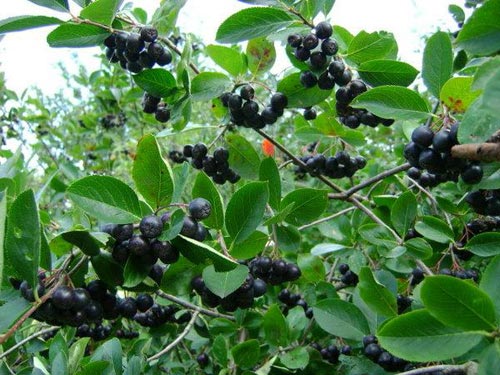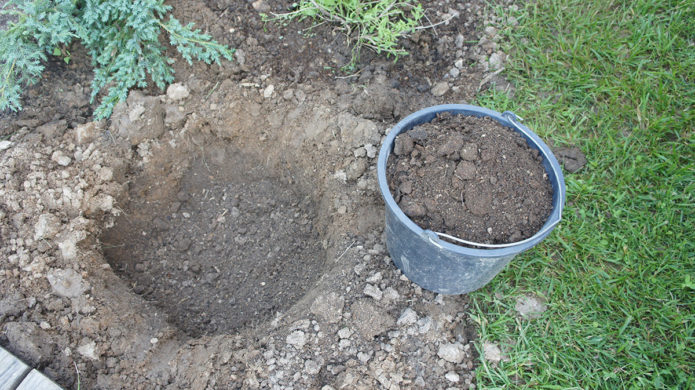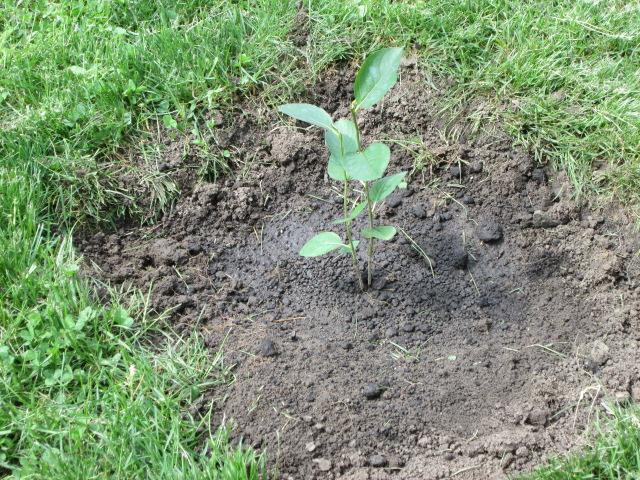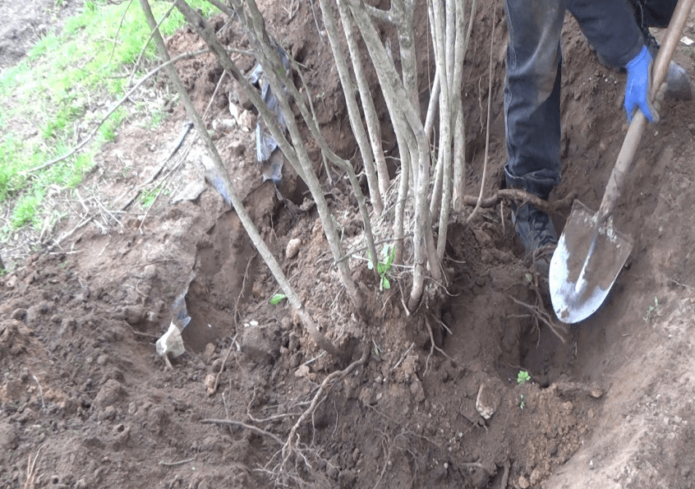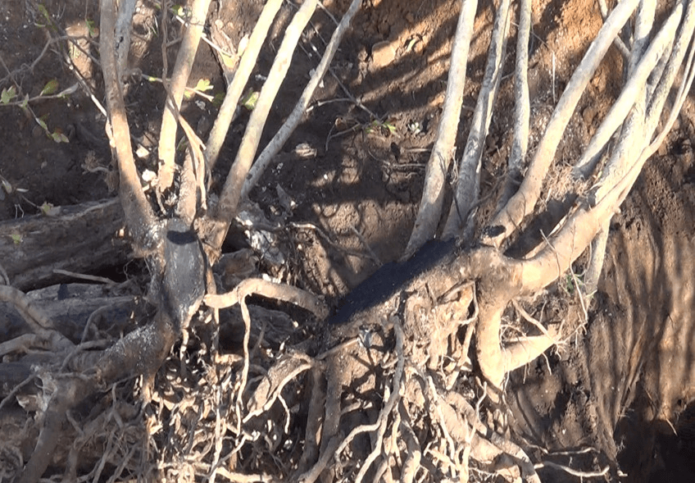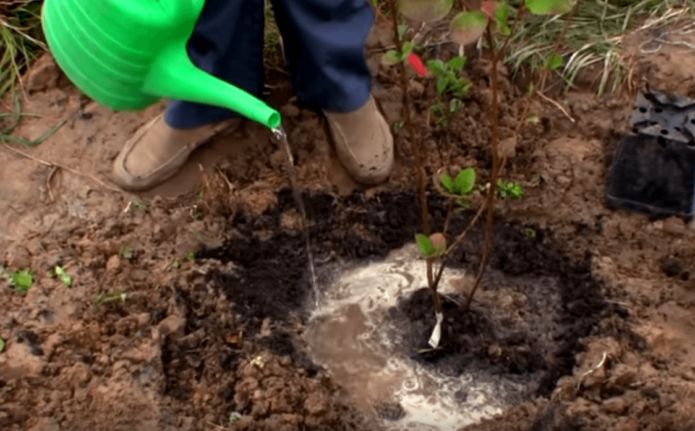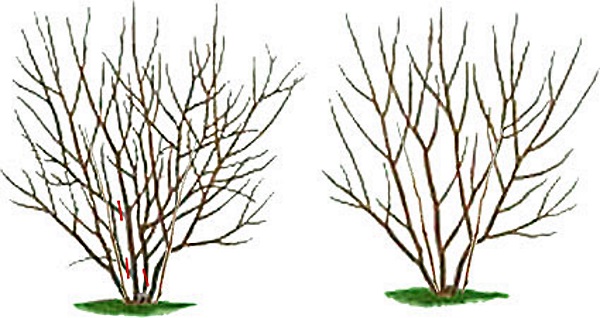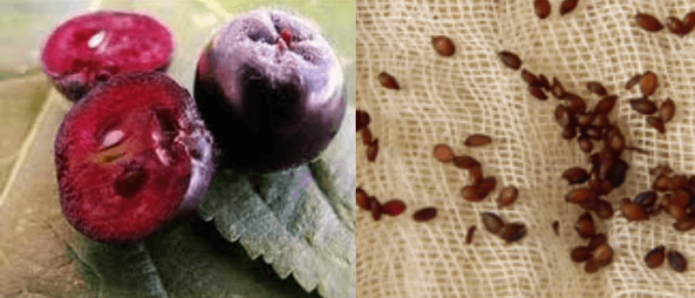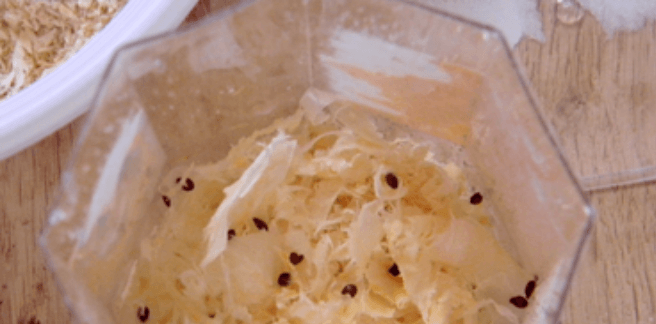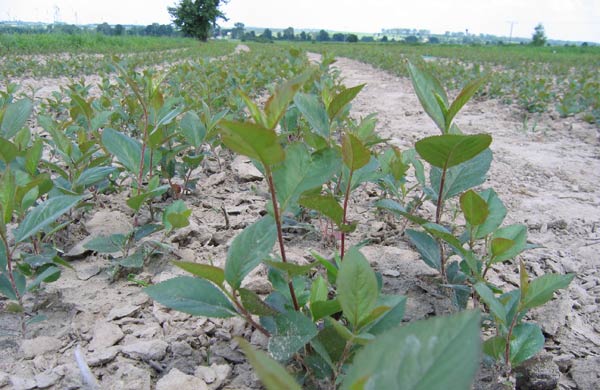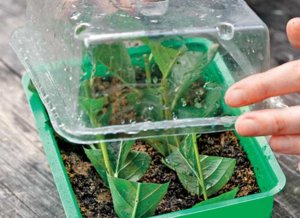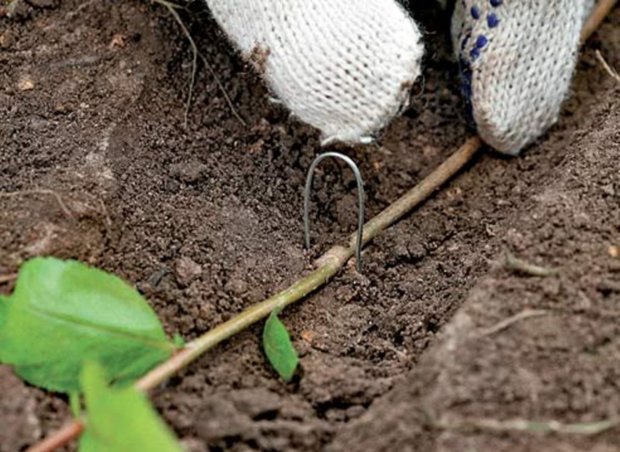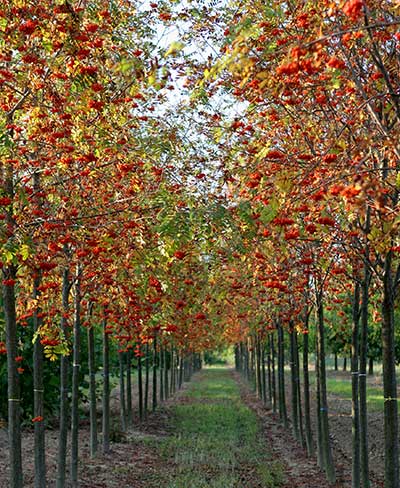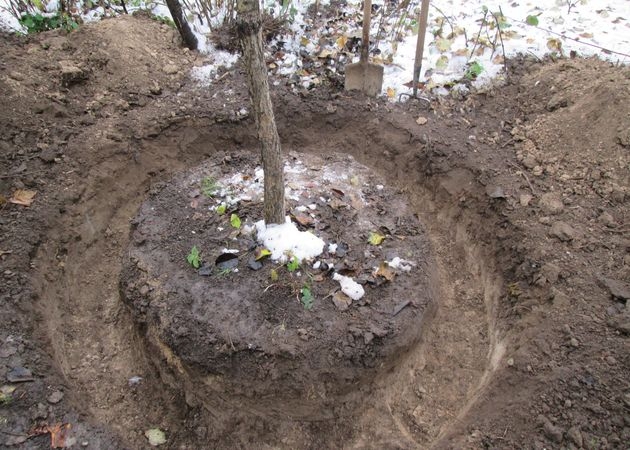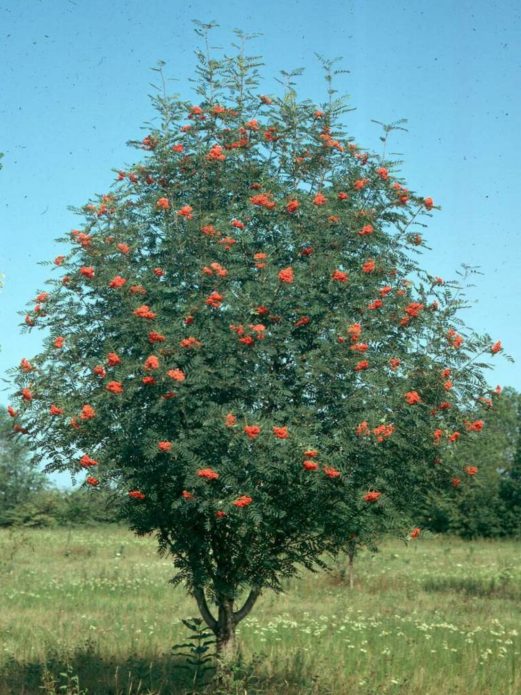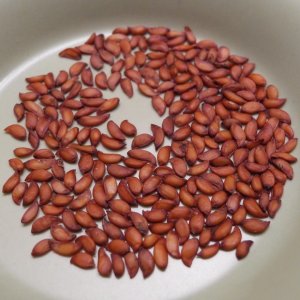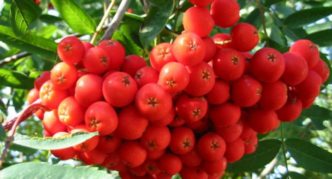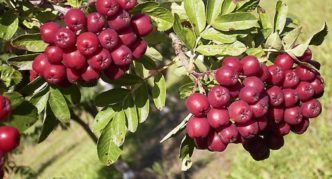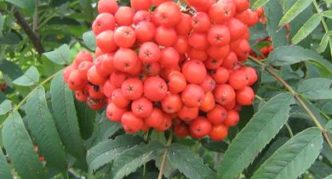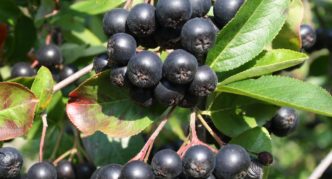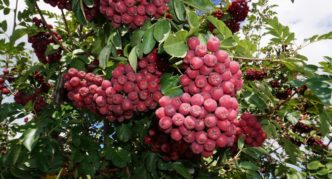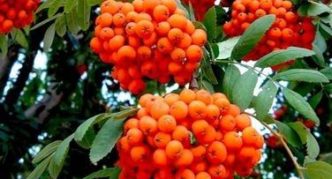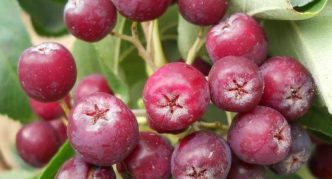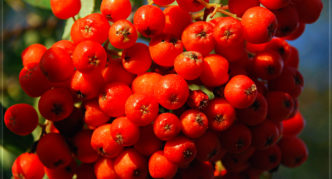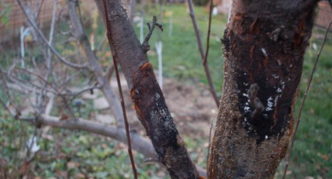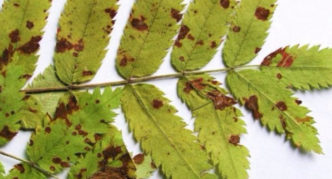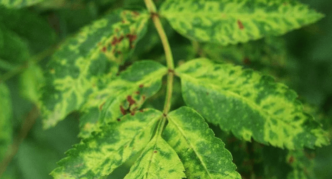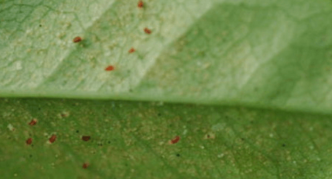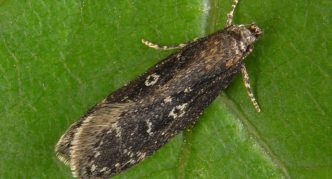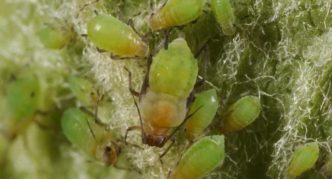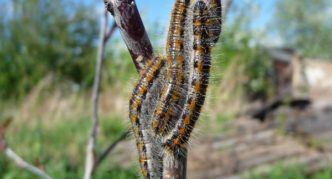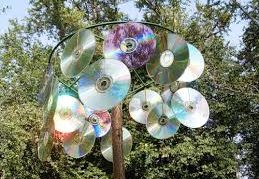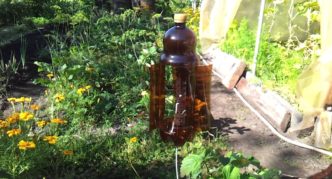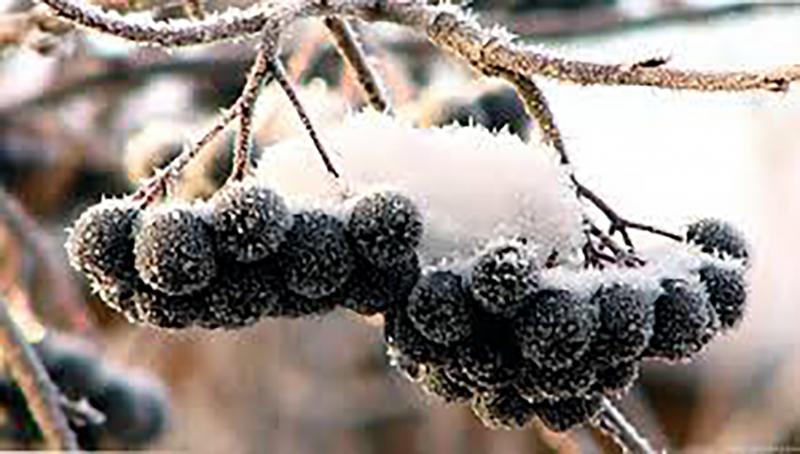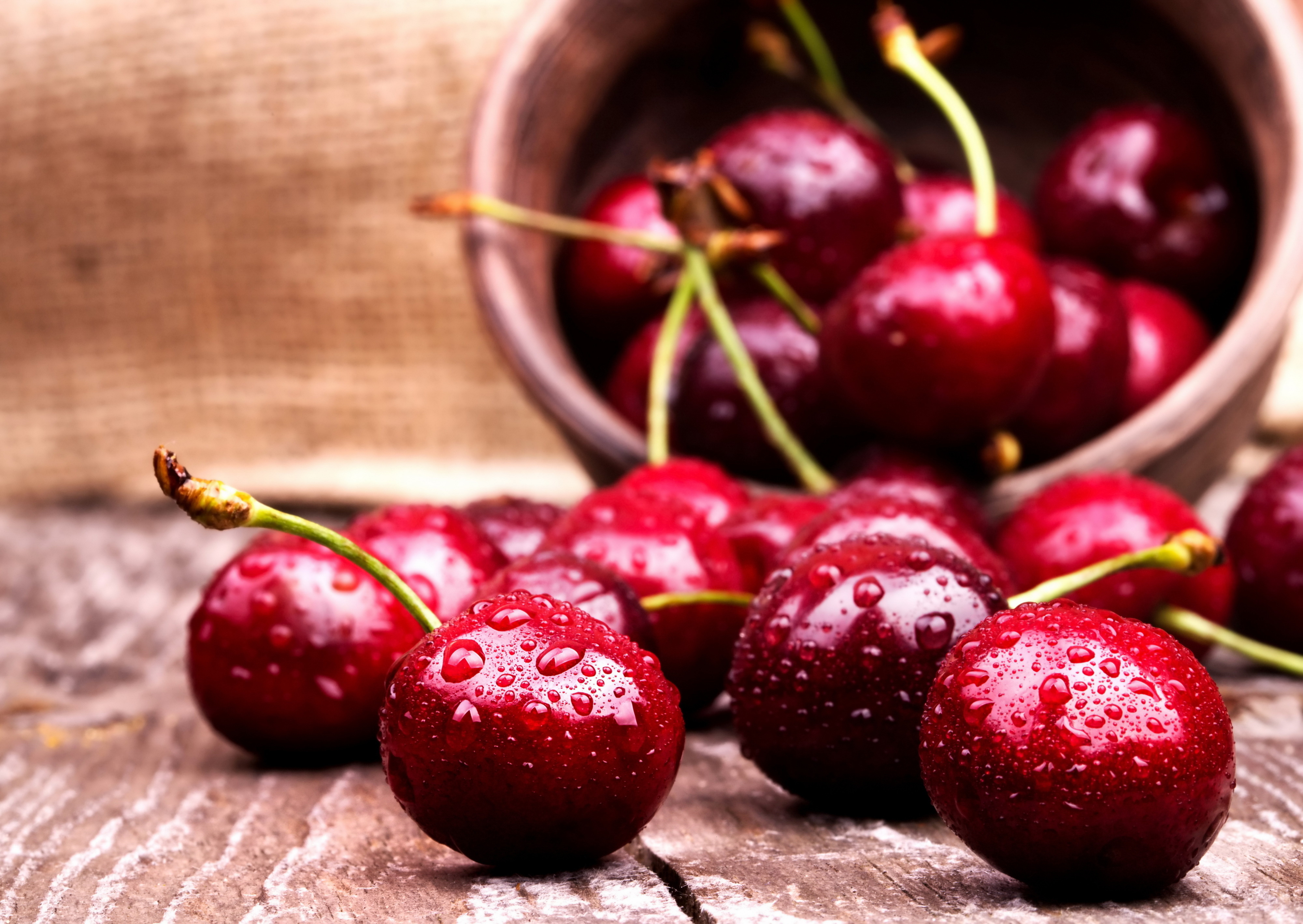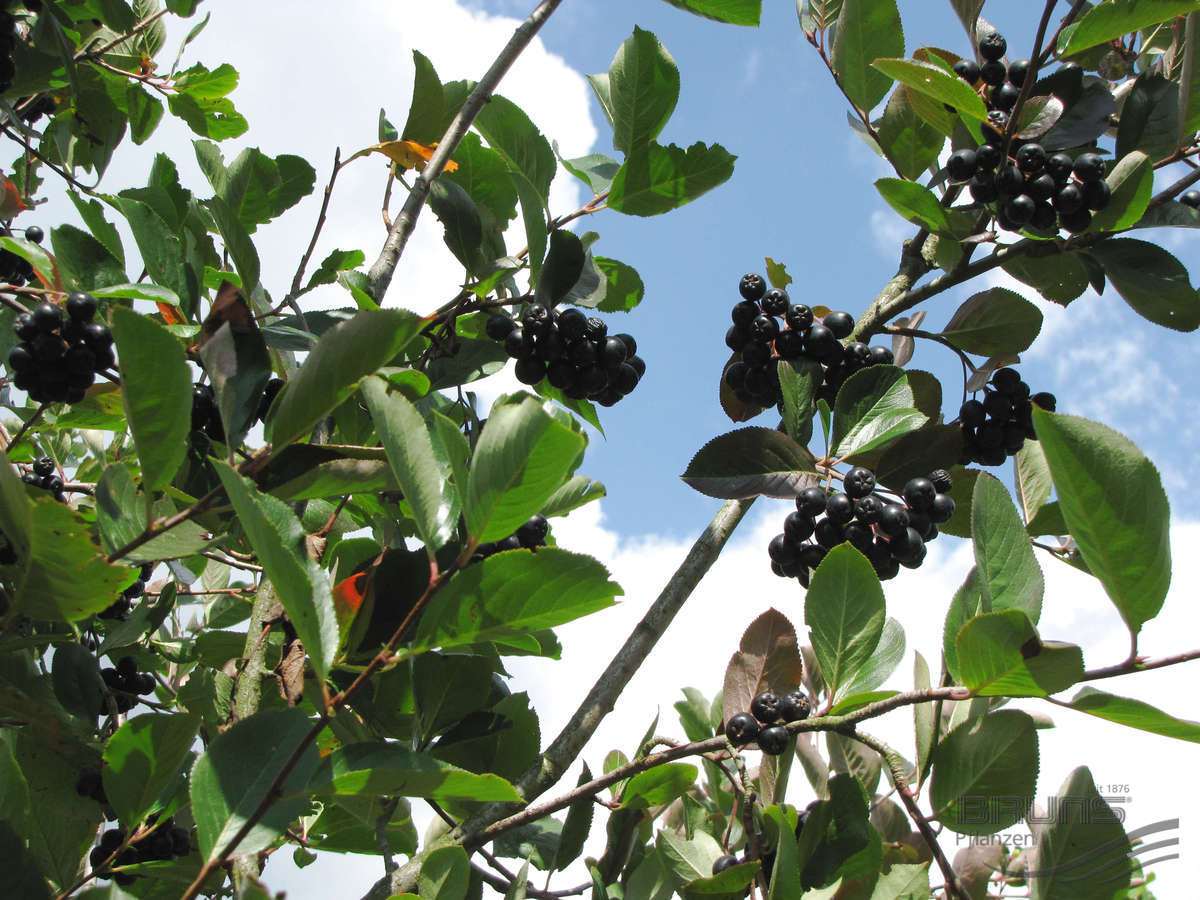The pink family unites about 3 thousand species of different plants. Among them there are two most interesting genera - Aronia and Rowan. These are related plants, it is not for nothing that the popular name for chokeberry is chokeberry. But in addition to general features, they are very different in appearance, structure of leaves, distribution area, requirements for growing conditions.
Content
Rowan black chokeberry (chokeberry)
Chokeberry is a shrub that grows up to 3 meters in height with a spreading crown. The bush consists of uneven-aged stems, it is fast-growing - it begins to bear fruit a year after planting.
Chokeberry is not capricious. Winter hardiness, disease resistance, undemanding soil fertility, easy survival in a new place are the characteristic features of this culture. Its globular, coal-black fruits have a sweet-sour flavor and astringent astringency. They are real treasures of usefulness: vitamins and minerals. Chokeberry berries are universal in use: jams, compotes, jellies, juices from them are very tasty and retain all the healing properties.
But I want to say about the chokeberry. Planted in 2007 in early spring, the dwarf black chokeberry, in the same year, bloomed very much, and by the end of summer it fruited, and such large berries and clusters were surprisingly. We thought our tree would disappear, but this year everything repeated again, strong flowering and even more harvest. I dried the berries, cooked compote, but I won't do that anymore, the taste is not the same, I didn't like it. Next year I will make jam or compote, it is not suitable to dry.
And I have a blackberry at least 3 meters. Perhaps even a little higher. With "bare feet", very well closes the area from the road.
The appearance is still very much on the landing site, probably depends, well, on leaving. I got an old bush and in partial shade - high (about 3m or more) and "barefoot".A neighbor's in the sun - no higher than 2m and fluffy. Now I am trying to rejuvenate and form my own, in March I cut off 2/3 of the old branches at the base and over the summer the young ones have grown already about 1 m tall. Next spring I plan to form a new bush from this growth, I just don't know if I can make it fluffy because of the shade.
Chokeberry is the easiest way to propagate by shoots from a bush. Or horizontal layering. Faster and more reliable.
Growing chokeberry
It is not at all difficult to grow a chokeberry bush, caring for it does not require a lot of care and effort. It is important to know the characteristics of the plant and properly organize the preparatory work: choosing a site for planting, preparing the soil, selecting seedlings.
Chokeberry - medicinal properties and contraindications to the use of chokeberry:https://flowers.desigusxpro.com/en/lekarstvennye-rasteniya/chernoplodnaya-ryabina-lechebnyie-svoystva-i-protivopokazaniya.html
Choosing a place and a predecessor in the garden
The blackberry does not have any special requirements for soil fertility. It can grow on any soil, but active development and good fruiting is achieved on light neutral loams. High soil fertility can lead to excessive formation of the green mass of the plant, while the yield will suffer. Well-lit areas are comfortable for the plant, but even with light openwork shading, the bushes also grow and bear fruit well. Aronia is quite tolerant of the close location of groundwater, since its roots do not go deeper into the ground than half a meter.
Note! Chokeberry is often used to organize hedges.
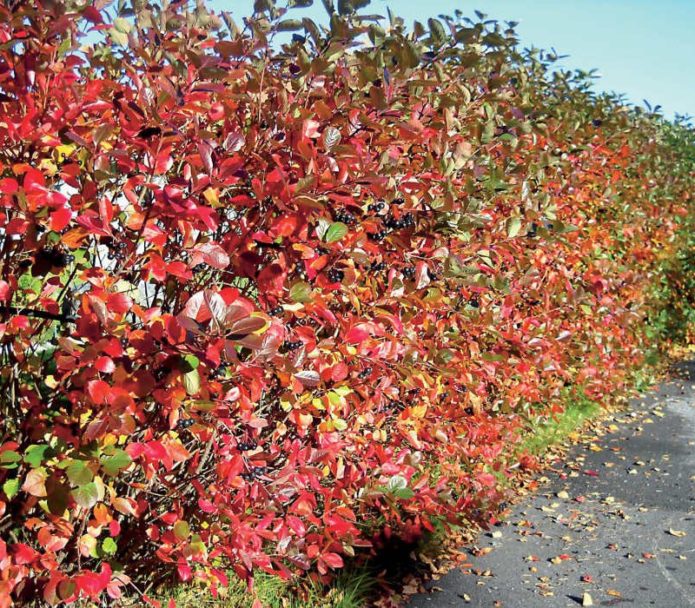
The chokeberry hedge has an excellent appearance, a dense crown, low growth and ease of pruning and caring for it
Chokeberry is a perennial plant, therefore, the choice of a site for planting must be approached responsibly. Errors made will not only adversely affect the plant, but can also create problems with the transfer of an adult bush to another place.
Important! It is best to keep the place under the chokeberry a year before planting, or grow green manure plants on it: clover, lupine, alfalfa. They will increase the content of organic matter in the soil, contribute to the accumulation of nitrogen and the quality distribution of mineral fertilizers.
Planting pit preparation
The planting pit for chokeberry should correspond to the size of the root system. Its approximate dimensions are 60x50x50. The infertile soil layer removed from the pit must be mixed with the following fertilizers:
- superphosphate (10 tablespoons);
- potassium sulfate (2 tablespoons) or wood ash (1 glass);
- a bucket of compost or humus.
Helpful advice! To improve the structure of clay soil, add a bucket of peat. This will increase the looseness of the soil, its moisture and air permeability.
Planting and transplanting
The best time to plant and transplant chokeberry is September-October or March-April. For the middle lane and southern regions, autumn planting is preferable: it reduces the risk of immature seedlings falling into drought. In the northern regions, on the contrary, it is better to plant the black chokeberry in the spring in order to avoid exposure to severe frosts on the young plant.
It is important to choose healthy seedlings for planting. This is evidenced by the condition of the root system, and not by the length of the shoots. It should be strong, healthy in appearance, have a greenish inner side of the bark and 2–3 rather long (about 30 cm) branches.
Recipes for preparations and dishes from chokeberry:https://flowers.desigusxpro.com/en/kustarniki/chernoplodnaya-ryabina-retseptyi.html
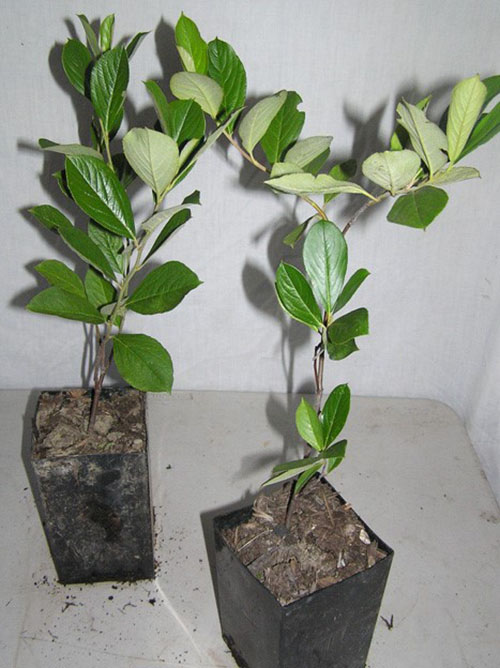
The closed root system of the seedling provides a higher survival rate, since the planting is carried out together with a clod of earth
Note! If the seedling has an open root system, then it must be inspected, the roots with breaks and damage must be removed, and before planting, dipped in a clay mash.
The planting process is carried out in compliance with the following stages:
- The pit is filled with a third of the volume of the prepared soil mixture, watered and waited for moisture to be absorbed.
- The roots of the seedling are spread in the planting pit.The root collar is placed 1.5–2 cm below ground level.
- The plant is covered with earth, compacted around the trunk and spilled again with water.
- It is recommended to mulch the space near the trunk.
Important! When planting several chokeberry bushes on a site, it is recommended to leave at least 2 meters of free space between them, otherwise the plants will shade each other, starve due to lack of space for food.
Video: planting chokeberry
Chokeberry transplant
When a situation arises of the need to transfer an adult chokeberry bush to a new place, it is important to correctly assess the feasibility, choose a favorable time and the best method. The best time to transplant is early spring. It is carried out as follows:
- You need to dig up the plant.
- Delete old branches from it.
- Clear roots.
- Place the bush in a pre-prepared planting hole.
Note! If necessary, an adult bush is divided into several parts. This is done with a sharp instrument, and the cuts are treated with charcoal.
Chokeberry care
Black chokeberry does not require much attention from its owners. There are no special subtleties when caring for her, all measures are standard and well-known:
- in early spring, the stems of the plant are whitened and, if necessary, treated against parasites and pathogens that hibernated in the soil and bark cracks;
- the trunk circle must be kept clean and loose;
- in the summer, the plant is periodically examined in order to notice signs of diseases or the appearance of pests in time;
- in early spring and autumn, pruning of the bush is carried out;
- young plants are recommended to huddle high and cover for the winter with spruce branches, foliage.
Aronia is a drought-resistant plant, it will survive in a rainless summer, but it can bear little fruit, the fruits will be small, and the appearance of the plant will also suffer. Watering for the crop is desirable during the following growing seasons:
- at the beginning of active life, especially if there was little snow in winter, and the spring was dry;
- during the period of pouring and ripening berries;
- in the fall, when preparing the plant for winter.
Fertilizing culture
During the season, it is recommended to feed the chokeberry three times:
- The first nitrogen feeding is carried out in the spring before bud break: 50 g of ammonium nitrate under a bush.
- The second top dressing is recommended to be carried out on poor soils. For her, an infusion of organic matter is used at the rate of a bucket per bush.
- For the third feeding, you need superphosphate (50 g) and wood ash (1 glass) per bucket of water. Consumption - 10 liters of solution for a seedling and 20 liters for a fruiting bush.

Sprinkling wood ash on the soil surface under the bush not only fertilizes the plant, but also protects the trunk and leaves from pests
Carrying out pruning and crown formation
In early spring and autumn, you need to prune the bush. This procedure is organized for the following purposes:
- for plant formation;
- to improve illumination;
- for plant rejuvenation;
- for removing dead, damaged branches (sanitary pruning).
The formation of the bush begins almost immediately after planting. It is recommended to remove weak branches and cut off the rest at a height of 15–20 cm from the ground, so that no shoot becomes the leading one. The next year, up to 5 strong stems are selected from the root shoot and equalized. The rest of the growth is cut at the base. In the third year of life, the bush is replenished with 4–5 more branches.
Note! A full-fledged chokeberry bush should contain about 12 branches of different ages. A larger amount leads to thickening, shading, creating favorable conditions for pests and other pathogens.
At least twice a year, the bush is examined, damaged, with signs of disease, weak, drying up branches, and excess young growth are removed.
To rejuvenate the bush, branches over 8 years old are removed. A strong root branch is left instead of the cut ones. When choosing new shoots from the growth, it is important to ensure that the base of the bush does not grow.
Helpful advice! Complete rejuvenation will help radically renew the blackberry bush. When it is carried out, all branches are cut to the base. A young chokeberry bush is formed from the new root growth.
Vegetative and seed propagation of chokeberry
Culture can be propagated in various ways. We have already talked about one of them - dividing the bush. A fairly practiced method of obtaining new plants is seed. It is carried out as follows:
- Seeds are harvested from ripe, large fruits.
- The seeds are kept in water for 24 hours, which is periodically changed.
- The seeds are placed in wet sawdust and stored for a week at room temperature, and then the container with sawdust and seeds is closed with a lid and sent to the refrigerator (or dropped into the snow). In the cold, seeds are stored for about 3 months. Get them out of there a few days before landing.
- Sowing seeds can be done at home, in a greenhouse or directly into open ground. Do this in the spring in well-warmed soil. The seeds are placed in furrows with a depth of about 6 cm, covered with soil 0.5 cm and mulched with sawdust.
- After the appearance of real leaves, the crops are thinned out, leaving the seedlings at a distance of about 3 cm.
- In the phase of 4–5 leaves, a second thinning is carried out, removing excess plants at a distance of 6 cm from each other.
- During the season, the seedbed with seeds is systematically watered, weeds are removed, and the soil is loosened.
- The next spring, the plantings are fed with mullein infusion (1:10), and then the last thinning is carried out in 10 cm increments.
- Landing at a permanent place is carried out in the fall.
Vegetative propagation of chokeberry
Chokeberry can be propagated quickly and efficiently with the help of root suckers, which grow annually around the bush. With a sharp tool, they are cut off from the parent bush and transplanted to a new site. The top of the offspring is cut off after transplantation, leaving about 5 buds on the shoot.
Irga is an unpretentious ornamental plant that brings a harvest of healthy berries:https://flowers.desigusxpro.com/en/yagody/irga-lamarka-opisanie.html
The method of propagation of black chops by cuttings is simple in execution. Harvesting of green cuttings is carried out in May or early June:
- Take a young branch of the plant about 15 cm long.
- The lower part is freed from the leaves, several cuts are made on it.
- In the upper part, an incision is made under the bud and the leaves are shortened by 1/3.
- Then the cuttings are soaked in any rooting stimulator and planted in a container with a fertile mixture (earth + compost + ash).
- After 2 weeks, cuttings can be planted in open ground for further cultivation.
- Planting young plants in a permanent place is carried out in the fall of the next season.
For reproduction, you can also use lignified chokeberry cuttings.
Note! The survival rate of green chokeberry cuttings is about 95%, and lignified - no more than 30%.
The vegetative method of reproduction by layering is inexpensive and effective. To do this, in the spring, when digging the soil around the shrub, last year's healthy branch is selected and placed in the made furrow. After a while, young shoots will appear from the buds. Weeds are weeded around them, moisten the soil, carry out low hilling, sprinkle with humus. By the next spring, the rooted cut is separated from the parent bush and transplanted to a permanent place.
Video: Planting and caring for chokeberry
Mountain ash
The rowan, although it is called ordinary, in fact has a lot of extraordinary qualities: it is decorative, it bears tasty and healthy fruits, it is not demanding of heat and soil, is not afraid of the winds and, according to the beliefs of our ancestors, protects the courtyard from evil spirits. The underside of the rowan berry resembles a star in shape, and this is a symbol of protection, one of the main pagan symbols.
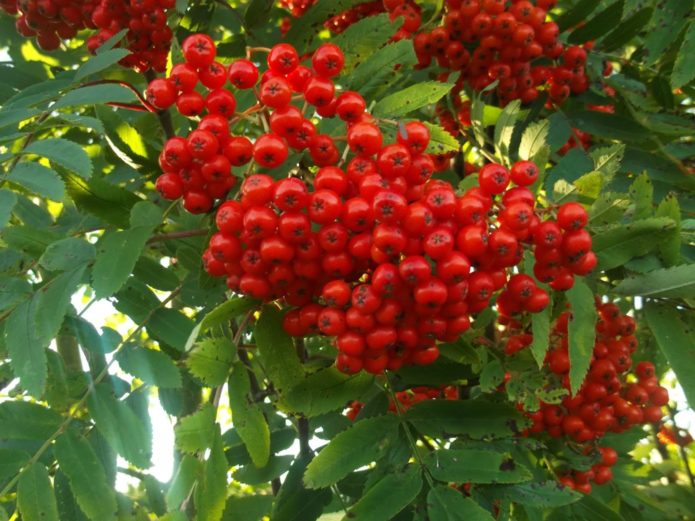
If you look closely at the underside of the rowan berry, you will notice that in shape it is an equilateral five-pointed star, and this is one of the most important ancient pagan symbols - a symbol of protection
Rowan is most often a rather tall tree: in adulthood, it can reach 10-15 m in height. She has large leaves, consisting of 7-15 leaves, medium-sized white flowers are collected in large inflorescences.
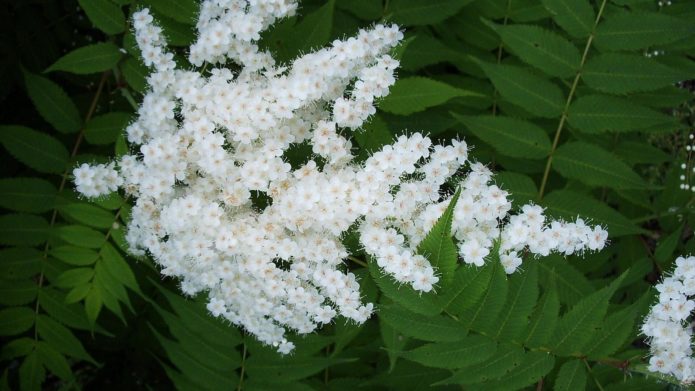
Rowan blooms very beautifully - in large clusters of white lush flowers, which are strewn with the entire crown
Note! Rowan is a seed crop. Its fruits are considered apples. They ripen at the very beginning of autumn, but they acquire an amazing taste after hanging on a tree for a long time and freezing cold.
Growing ordinary mountain ash in a personal plot
Planting rowan trees must be approached thoughtfully and seriously. The tree should grow in comfortable conditions, but since it is planted for more than a dozen years, you should think over the layout of the site for the future so that you do not have to transplant the mountain ash to a new place or get rid of it.
Choosing a site for planting and preparing the soil
Rowan is a tall tree, so it is better to plant it on the border of the site, you can along the perimeter of the garden. With such a planting, it will not shade fruit trees and ridges, and will protect them from cold northern winds. Mountain ash alleys growing along wide paths, as well as joint plantings with conifers and flowering shrubs look beautiful.
Rowan berries can grow in fairly shaded corners of the garden, but if you want to harvest a good berry crop, then it is better to choose an open, sunny place.
Note! Spruce, pine, cherry and raspberry coexist well next to the mountain ash. But the neighborhood with viburnum, lilac, jasmine, barberry, acacia, chestnut is unfavorable.
Common mountain ash, as well as chokeberry, is best planted after perennial grasses, vegetables and grain crops and green manure plants. It will grow normally on almost any soil, but the most suitable for it are light and fertile loams without excessive moisture. Wetlands and areas with a close occurrence of groundwater will not be comfortable for mountain ash.
Important! Acidified soils must be calcareous before planting mountain ash.
Planting and transplanting
The optimal timing for planting common mountain ash is mid-autumn or early spring. Spring planting is recommended for areas with severe winters with little snow. The technology for preparing a planting pit and planting seedlings does not differ from planting chokeberry.
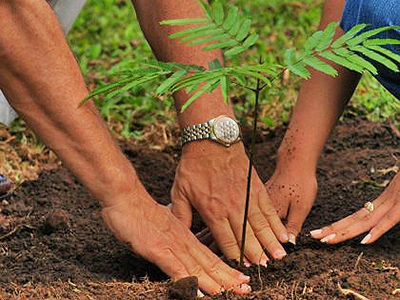
Pay attention to the location of the root collar after soil subsidence: it should be at ground level
Video: planting a rowan seedling
Rowan transplant
If a 4–5-year-old tree is transferred to a new place, then the event is carried out according to the rules for planting a young seedling.
Important! The only difference is that the plant must be dug up first. Remember that this must be done with caution, since rowan has a branched root system, which it is advisable not to damage.
Transplanting an adult tree is a complex and time-consuming procedure:
- During transplantation, the tree must be in a state of biological dormancy.
- A ditch is dug at a distance of 1 meter from the trunk. Large roots of mountain ash, caught in the way, are pruned.
- With the help of levers, the mountain ash is removed from the pit along with a lump of earth.
- An earthen ball on the root system is wrapped in burlap, laid on a film or iron shield and dragged to a new place.
- The planting pit should exceed the size of the earthen coma by about 40 cm.
- A drainage layer is made at the bottom of the pit.
- The tree is moved into the hole, maintaining its orientation to the cardinal points, buried and compacted with the earth around the trunk.
- Produce abundant watering, then mulch the soil in the trunk circle.
Important! Trees exceeding 3 meters in height cannot be transplanted.
Rowan care
The growing season of mountain ash begins early, so the main plant care activities are carried out as early as possible. All of these procedures are self-explanatory and include:
- removal of root growth;
- watering;
- weeding in the zone of the trunk circle; mulching;
- top dressing;
- loosening the soil.
Note! Abundant watering of the plant is carried out during the fruiting period.
If the planting pits were well filled, then the first two years of feeding the mountain ash are not needed. In the third year of life and all subsequent years, it is recommended to feed the plant as follows:
- Before flowering - 20 g of nitrogen, 25 g of phosphorus and 15 g of potash fertilizers per 1 sq. m landings.
- In summer - 15 g of nitrogen and phosphorus fertilizers, 10 g of potash fertilizers.
- After harvesting - 10 g of phosphorus and potash fertilizers.
Fertilizers are scattered in the near-stem circle and embedded in the soil shallowly.
Helpful advice! Once a year, the tree can be fed with infusion of mullein (1: 5) or bird droppings (1:10).
Sanitary pruning of mountain ash (removal of diseased and damaged branches) can be carried out all year round. Shaping pruning is best done in early spring before sap begins to flow. The crown of the tree begins to form at a young age. Only in this case the mountain ash will look beautiful and well-groomed and bear fruit abundantly. When pruning, you need to pay attention to the following points:
- shorten the central conductor, cut out its competitors so that the mountain ash does not grow high up;
- shorten strong annual growths by 1/3 in order to cause the formation of side ramifications;
- partially remove the branches going inside the crown;
- cut out intertwined branches, which will help to avoid thickening and create good breathability and light.
Video: trimming rowan
Reproduction
Red mountain ash, like chokeberry, can be propagated in several ways. The most practiced option is seed propagation. It is neither time-consuming nor labor-intensive.
Using this method of reproduction, it is necessary to take into account that seedlings do not always retain varietal characteristics and later enter the fruiting period. The technology for propagating rowan seeds by seeds is as follows:
- The harvested seeds are stratified according to the example of chokeberry.
- In early spring, the prepared seeds are planted in the ground and watered.
- The plot is covered with foliage or straw.
- In the fall, young shoots are transplanted into a nursery school.
Autumn sowing of seeds can also be carried out. For the winter, such plantings must be insulated so that freezing does not occur. Reproduction of common mountain ash by cuttings according to the technology corresponds to the reproduction of black chokeberry in this way.
Important! When using the grafting method of reproduction, it is practiced to carry out grafting into the cleft.
Rowan and chokeberry varieties, peculiarities of their cultivation in different regions
The distribution area of mountain ash and chokeberry is very wide. It is grown everywhere, and this process is not much different in different regions. In zones with a milder climate, the culture shows the highest productivity, requires less attention in care. Since most varieties of mountain ash are frost-resistant, they tolerate harsh Siberian conditions quite well. Only winters with little snow are dangerous, in which the roots of the plant can freeze out.
In the northern regions, it is recommended to bend the branches of shrub forms to the ground in order to prevent freezing of the shoots above the level of the snow cover.
When choosing mountain ash for a specific region, you should pay attention to the resistance of the variety to certain types of diseases. For example, in Siberia, in the Urals, in Yakutia, mountain ash is often affected by brown spot, and in the western regions such pests as May, raspberry beetle, scale insect are the most dangerous. The correct choice of a variety, knowledge of its characteristics will help to avoid many problems, to grow a productive and healthy tree.
Table: varieties of chokeberry and mountain ash
| Variety name | Ripening period | Features and benefits | Characteristics of the fetus | Characteristics of the tree |
| Scarlet large | Mid late |
|
| Tree up to 5 m tall with a wide-pyramidal crown |
| Black Pearl (Black Pearl) | Mid late |
|
| Shrub up to 3 m tall with powerful shoots |
| Burka | Early autumn |
|
| Shrub or small tree (up to 2 m), compact crown |
| Bead | Early | Highly resistant to extreme frost, heat, pathogens. High-yielding. |
| The tree is about 3 m high, the crown is round |
| Vefed | Mid-season |
|
| The tree is distinguished by its medium height and a rounded thin crown |
| Viking | Mid-season |
|
| Shrub (up to 2.5 m) with an inverted cone shape |
| Pomegranate | Early autumn | Winter-hardy, high-yielding, early fruiting (from 3 years of age) | Differs in the size of fruits that have a sweet and sour taste without bitterness | Hybrid of common mountain ash and hawthorn. Tree up to 4 m high |
| Liqueur | Mid-season | Not afraid of winter frosts, adult plants tolerate droughts well |
| Obtained by crossing black-fruited and common mountain ash.The tree is characterized by a medium height (up to 5 m) and an oval-sparse crown. It is found in bush form. |
| Michurinskaya dessert | Mid-season | Not afraid of winter frosts, resistant to sunburn. The fruits are mainly used for processing. |
| The tree grows up to 4 m |
| Moravian | Mid-season | Highly resistant to extreme frost |
| Tall tree with a narrow-pyramidal and then wide-pyramidal crown |
| Nizhinskaya | Early autumn |
|
| Tree up to 6 m tall |
| Ruby | Mid-season | Frost resistance, versatility of fruit use (including drying) |
| A low tree, closer to a dwarf tree (about 2 m) with a drooping crown |
| Sugar Petrova | Mid-season |
|
| Medium height (up to 5 m) |
| Fabulous | Late autumn |
|
| Medium-sized tree with an oval, medium-dense crown |
| Titanium | Mid-season | High frost and drought resistance, annual fruiting |
| Tree (up to 5 m), round crown, medium thickened |
| Fastigiata | Early autumn | High frost resistance and shade tolerance |
| Medium-sized, but closer to a tall tree (about 8 m), has a narrow-pyramidal crown. |
Photo gallery: varieties of mountain ash and chokeberry
- Large mountain ash variety Alai is capable of withstanding extreme frosts down to -50⁰С
- Burka fruits are especially good for processing
- The bead is one of the first varieties without a tinge of astringency.
- The fruit of the Vefed variety tastes good when fresh, even immediately after picking
- This beauty came to our country from Finland and immediately became popular with gardeners for its resistance to winter cold and rich harvests
- The Pomegranate rowan tree lives on average from 20 to 25 years
- It got its name from the village "Nevezhino" of the Vladimir region (Russia), where it has been grown for over 100 years
- Variety Rubinovaya obtained by pollination of common mountain ash with a mixture of pollen from different varieties of pear
- The average yield of the Skazochnaya variety during the full fruiting period is 126.9 c / ha
Reviews of rowan varieties
I have a "cognac" Ruby red-fruited ... it is not tart, but you can hardly call it sweet either
I don't know about the others, but Vefed is very tasty, without bitterness and astringency, with an interesting bouquet. Nice to eat straight from the tree.
The Titan variety has excellent quality processed products. The fruits can be used both for infusions and for various sauces. Variety Scarlet Krupnaya is perfect for jam, compotes, candy fillings, and, of course, tinctures.The Rubinovaya variety is suitable for preparing a dried product; it is often used in dried fruit compotes. The Businka variety is suitable for tinctures, jelly, fruit drinks, it is also used as an acidifier in confectionery.
But most of all I like Pomegranate. It is a hybrid of common mountain ash and hawthorn. Delicious, especially after the frost. There is no bitterness at all. And large. And what their liqueurs are obtained!
Variety Pomegranate is the most valuable variety; foreigners are actively interested in it.
Diseases and pests: one for two
Aronia and mountain ash are plants resistant to the absolute majority of diseases and pests. But occasionally they can suffer from diseases, so a preventive examination of bushes and trees is important, which will help in time to identify signs of disease or the presence of pests. And timely measures are the key to success in combating these problems.
Table: diseases of chokeberry and mountain ash, methods of dealing with them
| Disease | Signs | Control and prevention measures |
| Brown spot | Small brownish spots on leaf blades, white bloom on the underside of the leaf. Gradually the leaves dry, fall off | Removal of fallen and damaged foliage, spraying the plant with a 1% solution of Bordeaux liquid |
| Septoria spot | Brownish spots on the leaves have a dark border. The tissue inside the stains gradually dies off | Removal of fallen and damaged foliage, spraying the plant with a 1% solution of Bordeaux liquid, Abiga-Peak preparation (according to the instructions) |
| Bark cancer or bacterial necrosis | Flowers, shoots, fruits dry up, but do not fall off, but stay on the bush. The bark darkens, exudes a fermentation smell. | Removal of affected branches with the obligatory processing of cuts with garden pitch. In case of severe damage - uprooting and complete burning of the bush |
| Viral ring mosaic | Rings of greenish-yellow color on the leaf plates, which gradually connect and form a pattern resembling a mosaic. Leaves are deformed, die off | Removal of fallen and affected foliage |
| Grebenshik | Leathery grayish-brown growths on the roots of chokeberry | Seasonal treatment with 1% solution of Bordeaux liquid or with Abiga-Peak |
| Fruit rot | The tissue of the fruit of the culture is damaged. In dry weather, the wounds can dry out and the destruction of the berry is suspended. At high humidity, destruction resumes | Timely harvest |
| Powdery mildew | Whitish coating on various parts of the plant | Pollination with ground sulfur and lime (2: 1) at the rate of 0.3 g / sq. m, collection and destruction of fallen leaves |
| Rust | Yellow spots with dark dots on the leaves | Bordeaux liquid treatment, removal of affected branches |
Photo gallery: diseases of chokeberry and mountain ash
- If the mountain ash is first covered with an orange bloom, and subsequently begins to dry out and dies, then the plant has been attacked by rust
- The rapid development of fruit rot is favored by warm (plus 24 - 28 degrees) and humid (at least 75%) weather, thickened plantings
- The causative agent of cancer penetrates through unprotected areas of the cortex - wounds and cracks
- If the leaves of the mountain ash turn black and die, and the next year the amount of the crop decreases markedly, most likely it is brown spot
- Viral ring mosaic creates a pattern similar to a yellow-green mosaic
- Spores of mycelium, a microscopic fungus, are visible on the leaves as a white coating that can be easily removed with your fingers
Table: pests of chokeberry and mountain ash, control measures
| Pests | Signs of defeat | Control and prevention measures |
| Hawthorn | Caterpillars damage the leaves, buds and flowers of the plant | Insecticide treatment:
|
| Leaf weevil | Damages and eats plant leaves | Karbofos (10 g / 10 L of water) or Chlorofos (20 g / 10 L of water) |
| Cherry Slime Sawfly | Destroys the leaf plate, leaving only large veins | Treatment (according to the instructions) with drugs:
|
| Green apple aphid | Curling and drying of leaves and shoot tops | Treatment with drugs:
during bud break and before flowering. |
| Fruit mite | Silvery outflow of branches due to discarded larval skins of the pest | Spraying in early spring with Oleocubrite, Nitrafen, Zolon, Karbofos. Autumn digging of soil under a bush, removal and destruction of fallen leaves. |
| Rowan moth | Caterpillars eat up narrow passages in the fruit pulp. Berries become unusable | Autumn digging of soil under a bush, removal and destruction of fallen leaves. Spraying with Chlorophos (20 g / 10 l of water) or with Fastak, Kinmiks, Fufanon-nova preparations (according to the instructions) |
Photo gallery: pests of chokeberry and mountain ash
- With a massive spread of the fruit mite, the yield loss can be up to 30%
- The mountain ash moth hibernates in the form of a pupa in the upper layer of the soil, its emergence to the surface coincides with the flowering of apple and mountain ash
- The larvae of the cherry mucous sawfly do not damage the berries themselves, feed exclusively on the leaf tissue, but with a strong infection, they significantly weaken the plant, which affects the yield
- Aphids, developing on fruit trees and shrubs, have turned into a real living pump, pumping out vegetable juice from them
- Hawthorn caterpillars overwinter in nests of damaged leaves held together by cobwebs
- Young beetles emerging from the ground destroy the shoots, color, and later foliage of young trees
Important! Treatment of plants with chemicals must be stopped a month before harvesting!
Birds can cause great damage to the harvest of mountain ash and chokeberry. To scare them away, they use various shiny objects (used computer disks, New Year's tinsel), scarecrows, as well as devices that make unpleasant sounds from contact with each other or from gusts of wind - tied aluminum cans, cut plastic bottles. If the death of the crop due to bird raids occurs constantly, then you should think about purchasing an ultrasonic bird repeller.
Photo gallery: bird scarers
- Discs, sparkling in the sun, and creating a specific noise, will scare away birds
- Rotating from gusts of wind, the pinwheel creates a noise that scares away birds
- Bioacoustic scarers are designed to scare away all types of birds: crows, jackdaws, rooks, magpies, sparrows, starlings, swallows, etc.
Rowan is a classic of the Russian landscape. It is extremely beautiful, and its decorative effect does not depend on the season. It is unique during the flowering period with fragrant clusters of white flowers. its leaves are attractive, which turn orange and crimson in autumn. And the berries ripened on the branches are scarlet, red, yellow, pink, white and black, which are not afraid of frost and stay on the tree for a long time! Its fruits can be used to prepare delicious desserts and juices; their medicinal and dietary qualities are valuable. Given the ancient beliefs that mountain ash is able to protect a house from evil spirits, it is worth thinking about growing this plant in your courtyard. And it doesn't matter at all which mountain ash you choose - black or ordinary.
